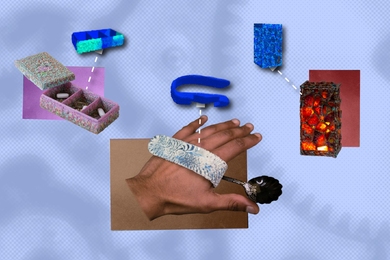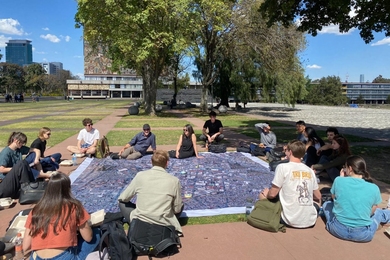Scientists from around the world have been contacting an MIT laboratory for samples of "biorubber," a new material with myriad applications including engineered lungs, heart valves and other elastic tissues.
Biodegradable polymers that are safe to use in the human body are already used in drug delivery, tissue engineering and more. Whether impregnated with medicine or serving as a scaffold for growing cells, such polymers are eventually absorbed by the body when their work is done.
Until now, however, none of these polymers has had the defining property of a rubber band: the ability to stretch and then snap back to its original shape. The dominant material in today's market is hard and brittle.
"If you think about it, though, many of the organs in the body are elastic," said Robert Langer, the Germeshausen Professor of Chemical and Biomedical Engineering. For example, the tiny air sacs in lungs expand more than seven times when you inhale. "So if researchers engineer replacements for these organs some day, they certainly want them to mimic the original tissues," he said.
Hence the query Langer received eight years ago from Dr. Joseph P. Vacanti, head of surgical transplantation at Massachusetts General Hospital. Vacanti, who has collaborated with Langer for years, asked the MIT engineer if he could make an elastic polymer for use in tissue engineering.
Biorubber, announced in the June issue of Nature Biotechnology, is the result. Langer's coauthors are Yadong Wang, a research associate in chemical engineering; Guillermo A. Ameer, a chemical engineering postdoctoral associate now at Northwestern University; and Barbara J. Sheppard, a comparative pathologist in the Division of Comparative Medicine (now at the Wyeth Genetics Institute).
"This work is extremely important and represents the culmination of several years of effort specifically aimed at new materials that could have applications in the field of tissue engineering," Vacanti said. "Because of the physical characteristics of the material, it could act as scaffolding to help in the design of heart tissue, blood vessels, cartilage, bone and many other structures of the human body, including whole organs for transplantation. We are now working with Drs. Wang and Langer in exploring its use in these areas of tissue engineering."
In addition to being strong, biocompatible and inexpensive (because the researchers can make it in large quantities of some 400 grams per batch), biorubber also has a number of other advantages. For example, due to its general chemical composition, it can be easily tailored to have a variety of different properties, such as a fast or slow degradation rate, for different applications. Biorubber's brittle counterparts are much more difficult to modify.
Although the new material has yet to be approved for use in humans by the Food and Drug Administration, a process that could take years, Wang is optimistic about its success. That's because its two principal building blocks are well known to be nontoxic. One of these, glycerol, is common in all of our cells, and the other received FDA approval in 1996 for use in another polymer developed by Langer for drug delivery.
Even before publication of the biorubber "birth announcement" in Nature Biotechnology, several scientists learned of the new material from visits to Langer's lab. Wang has sent samples to researchers in the United States, the United Kingdom, Singapore, Japan and New Zealand. They in turn have been exploring biorubber's applications in engineering blood vessels, heart valves, liver and cartilage.
"It's amazing to see how far this project has come," Wang concluded.
The work was sponsored by the National Heart, Lung and Blood Institute.
A version of this article appeared in MIT Tech Talk on June 5, 2002.






